|
Georges Laporte.
Georges Laporte. Affiche éditée à l'occasion de l'exposition "Georges Laporte Peintures", à la galerie Cambacérès, du 18 février au 2 mars 1967
Paris à la Galerie 1967 1 Une seule affiche de dimensions 49 x 64 cm; impression offset de l'imprimerie A.D.I.A, Nice.
Ссылка продавца : 15887
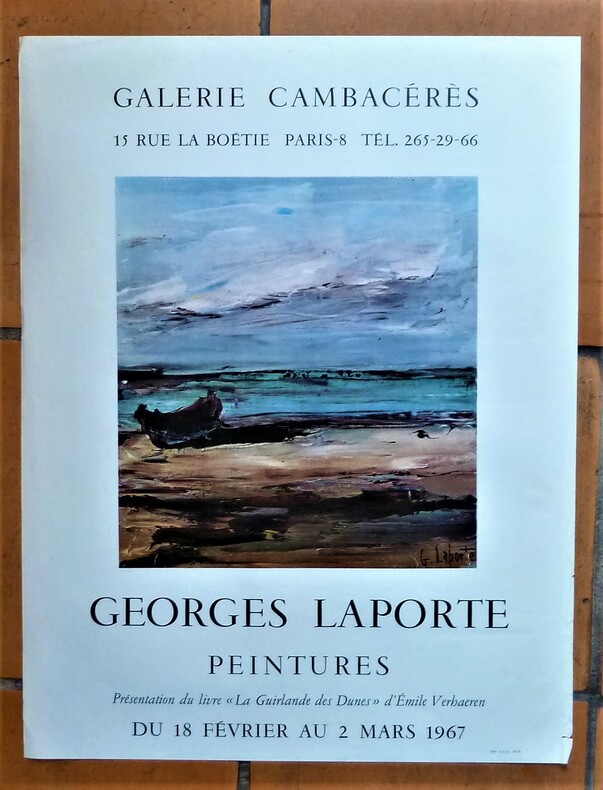
|
|
|
Georges ROUAULT
Jeanne D'Arc
Paris Musée du Louvre 1964 Affiche lithographique grand format . Affiche imprimée par Mourlot à l'occasion de l'exposition consacrée à la donation des oeuvres de Georges Rouault à l'état faite en 1963. Lithographie exécutée par Henri Deschamps d'après une huile sur papier peinte vers 1939. Exemplaire grand format 160 X 119 cm. Format de l'illustration : 104 X 72.5 cm. Papier légèrement roussi dans la partie supérieure de l'affiche.
Ссылка продавца : 23aff12
|
|
|
GEORGES A. BORIAS
L'AFFICHE+ 24 DIAPOSITIVES.
PUBLICATIONS FILMEES D'ART ET D'HISTOIRE. 1966. In-12. Relié. Etat d'usage, Couv. légèrement passée, Dos satisfaisant, Intérieur frais. Broché de 143 pages avec quelques illustrations en noir et blanc das et hors texte + 24 dipositives dans un étui plastique, réunis dans une reliure toilée rouge avec titres dorés au dos et sur le premier plat.. . . . Classification Dewey : 741.67-Illustrations des affiches
Ссылка продавца : R260107462
|
|
|
GEORGES BRAQUE
Le Couple
Genève Galerie Edwin ENGELBERTS 1963 Affiche lithographique. Lithographie originale en 8 couleurs imprimée par Mourlot pour la présentation du livre de René CHAR : LETTERA AMOROSA illustré par Georges Braque. L'affiche reprend une des lithographies du livre. Cet ouvrage édité par la galerie Engelberts comprenait 29 lithographies originales. Le couple ornait la page 53. Format de l'affiche : 64 X 40 cm. Braque Lithographe N° 140 , Dora Vallier N° 187
Ссылка продавца : 2024affbraque2

|
|
|
Georges BRAQUE
Oiseau bleu et jaune ( Grand Format )
Bâle KUNST HALLE BASEL 1960 Affiche lithographique grand format imprimée par Wassermann à Bâle en 1960 pour une exposition de Georges Braque. L'artiste s'est servi d'une lithographie originale éditée par Maeght quelques mois auparavant. Il l'a agrandie, remaniée et complétée de sa main en ajoutant de larges caractères.. ( Mourlot M 97 / Dora Vallier 147 / Wünsche 83 A) Tirage à 500 exemplaires , format 127 X 90 cm.
Ссылка продавца : 23aff18
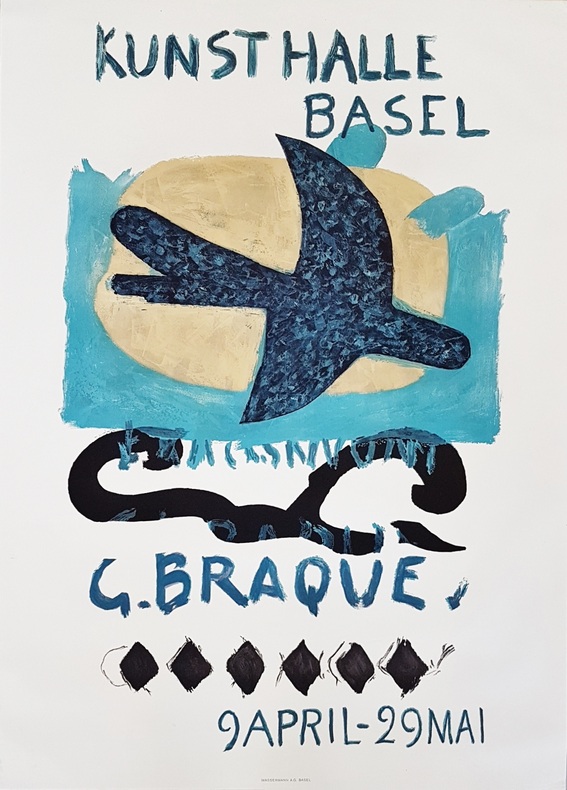
|
|
|
George Catlin.
George Catlin. Affiche éditée à l'occasion de l'exposition "George Catlin, Peintre des Indiens" au Centre Culturel Américaindu 8 novembre au 18 décembre 1963.
Une grande affiche de dimensions 59 x 85 cm; lithographie de Mourlot. Petites déchirures sans manque sur les marges; un angle coupé; sinon bien faîche. Voir photo.

|
|
|
Georges Goursat, dit Sem
[Personnage non identifié]
français Lithographie imprimée en couleurs provenant des célèbres albums de SEM, publiés entre 1900 et 1920. 50x32,5 cm.
|
|
|
Georges Goursat, dit Sem
[Personnages non identifiés]
français Lithographie imprimée en couleurs provenant des célèbres albums de SEM, publiés entre 1900 et 1920. 50x32,5 cm.
|
|
|
Georges Goursat, dit Sem
[Sans titre]
français Ensemble de 2 lithographies, l'une en noir, l'autre imprimée en couleurs provenant des célèbres albums de SEM, publiés entre 1900 et 1920. 32,5x50,5 cm.
|
|
|
Georges Goursat, dit Sem
[Sans titre]
français Ensemble de 2 lithographies, l'une en noir, l'autre imprimée en couleurs provenant des célèbres albums de SEM, publiés entre 1900 et 1920. 32,5x50,5 cm.
|
|
|
Georges Goursat, dit Sem
C'est aujourd'hui ma fête!
français Ensemble de 2 lithographies, l'une en noir, l'autre imprimée en couleurs provenant des célèbres albums de SEM, publiés entre 1900 et 1920. 33x50,5 cm.
|
|
|
Georges Laporte.
Georges Laporte. Affiche éditée à l'occasion de l'exposition "Georges Laporte Peintures", à la galerie Cambacérès, du 18 février au 2 mars 1967
Une seule affiche de dimensions 49 x 64 cm; impression offset de l'imprimerie A.D.I.A, Nice. Marge inférieure droite frippée avec petite fente; sinon bon état. Voir photo. Peu fréquente.

|
|
|
GERBAUD (Philippe).
"Dimanche".
L'Atelier Eric Seydoux Sérigraphie sur vélin d'Arches, signée en bas à droite à la mine de plomb, numérotée en bas à gauche, cachet sec de l'Atelier en bas à gauche, Paris, L'Atelier Eric Seydoux, 52 x 38 cm. (format à vue), 65 x 50 cm. (format de l'affiche)
Ссылка продавца : 24532
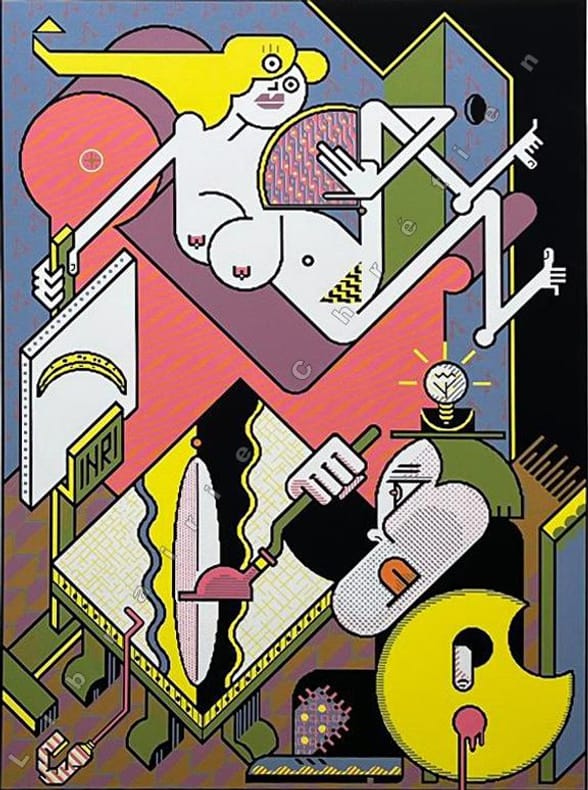
|
|
|
Gerber:
007.
Sérigraphie Humbert-Droz, 1991. Affiche sérigraphiée grand format, faisant partie d'une série réalisée par des dessinateurs du cru (toutes au format d'environ 70 x 100 cm.) célébrant à leur manière le 700e anniversaire de la Confédération suisse (1991, vous en souvient-il?).
Ссылка продавца : 3208
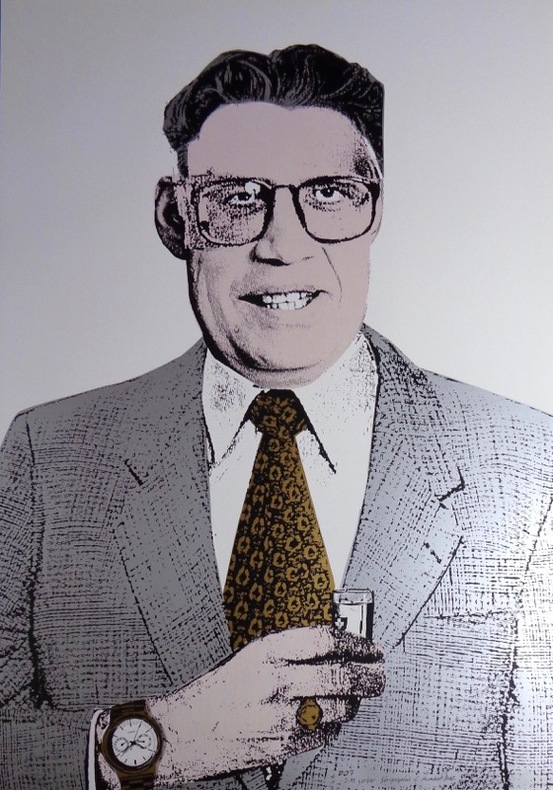
|
|
|
GERARD DEPARDIEU MIOU MIOU
1 LOT DE 3 PHOTOS LES VALSEUSES
BERTRAND BLIER. 1974. In-12. Broché. Bon état, Couv. convenable, Dos satisfaisant, Intérieur frais. 1 lot de 3 photos en couleurs.. . . . Classification : 0-Affiches Cinéma
Ссылка продавца : R100000514
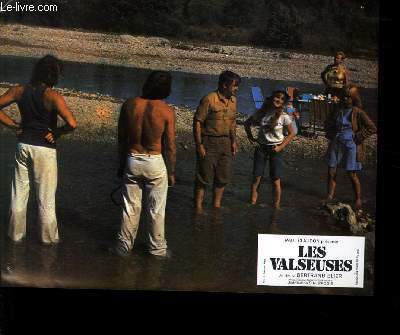
|
|
|
Gertsch, Franz (1930–2022)
Bois gravés monumentaux. Cabinet des estampes et musée Rath. Genève. 16 mars - 21 mai 1989.
1989. Serigrafie. Blattgrösse: 128 x 90 cm.
Ссылка продавца : 967DG
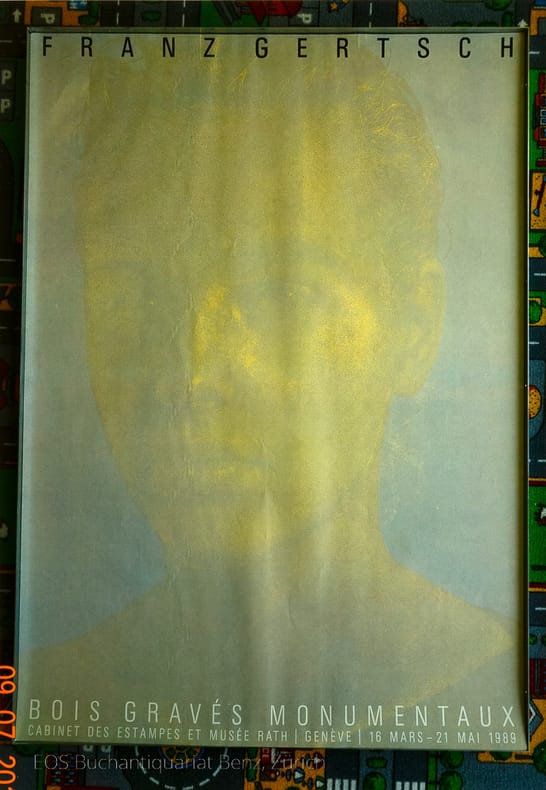
|
|
|
Gertsch, Franz (1930–2022).
Franz Gertsch - Im Kunsthaus Zürich.
Zürich, Kunsthaus Zürich, 1980. Serigrafie. Blattgrösse: 128 x 90 cm.
Ссылка продавца : 966DG
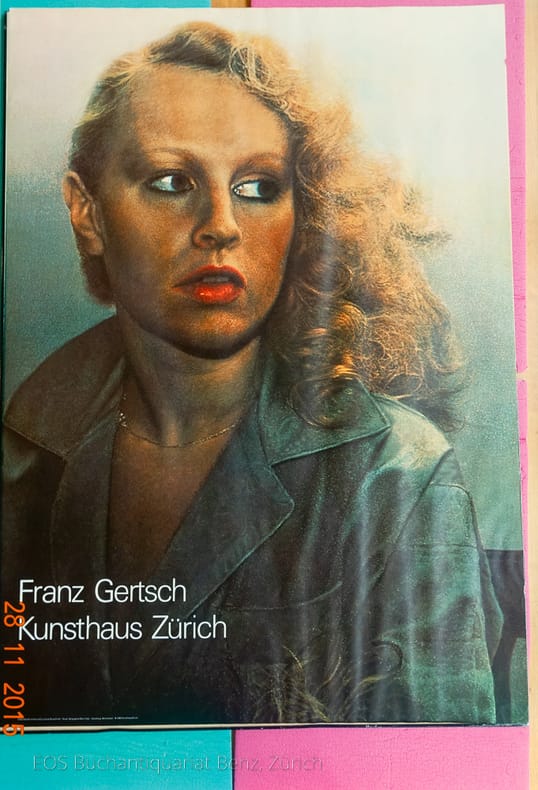
|
|
|
GERIN Octave Jacques
Précis intégral de publicité
Précis intégral de publicité avec le concours de E. DAMOUR, Louis SERRE. Mention de deuxième édition. In 8 broché, faux-titre, titre, VIII, 324 pages, illustrations dans le texte. DUNOD 1926. Rousseurs sur le premier plat de couverture.
Ссылка продавца : 12452
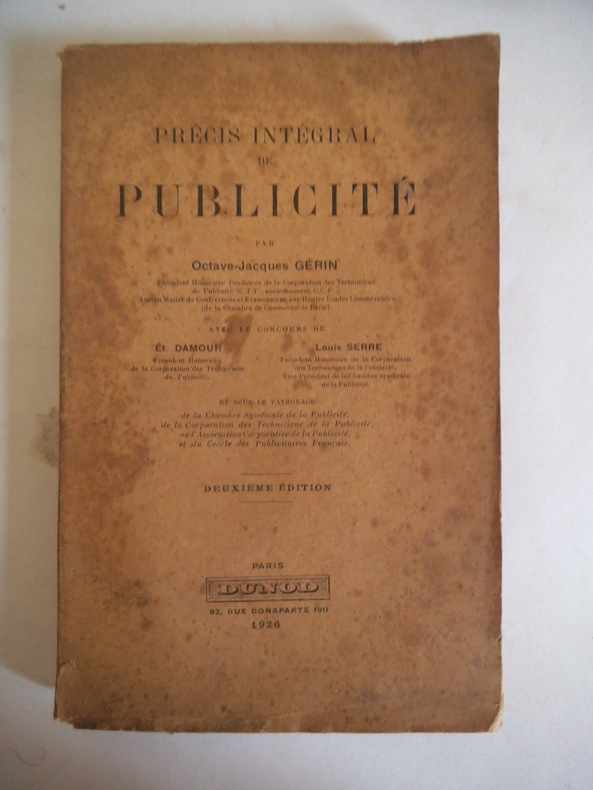
|
|
|
Gerkan, Meinhard von u.a
Unter großen Dächern. Von Gerkan, Marg und Partner. [Original-Ausstellungsplakat / original exhibition poster.]
o.J. [2 Warenabbildungen] (Meinhard von Gerkan, geb. 03.01.1935 in Riga, gest. 30.11.2022 in Hamburg, deutscher Architekt. Entwürfe für die Flughä
Ссылка продавца : 66091CB

|
|
|
Gertsch, Franz (1930?2022)
Bois gravés monumentaux. Cabinet des estampes et musée Rath. Genève. 16 mars - 21 mai 1989.
1989. Serigrafie. Blattgrösse: 128 x 90 cm. + Wichtig: Für unsere Kunden in der EU erfolgt der Versand alle 14 Tage verzollt ab Deutschland / Postbank-Konto in Deutschland vorhanden +, 967DG
Ссылка продавца : 967DG

|
|
|
Gertsch, Franz (1930?2022)
Franz Gertsch - Im Kunsthaus Zürich.
Zürich, Kunsthaus Zürich, 1980. Serigrafie. Blattgrösse: 128 x 90 cm. + Wichtig: Für unsere Kunden in der EU erfolgt der Versand alle 14 Tage verzollt ab Deutschland / Postbank-Konto in Deutschland vorhanden +, 966DG
Ссылка продавца : 966DG

|
|
|
Gerz, Jochen
Foto/Texte, The French Wall & Stücke. [Plakat / Poster] Kunstverein Braunschweig, 9. April-9. Mai 1976.
Braunschweig., Kunstverein., 1976. 83,5 x 59 cm., 729E Leichte Knickspur unten links, teilweise leicht fingerfleckig, sonst gutes Exemplar.
Ссылка продавца : 729EB

|
|
|
GESGON, Alain.
Affiches. Préface de Claude Manceron.
Paris : Club socialiste du livre, 1982. Un album in-4°, broché, rhodoïd.
Ссылка продавца : 21626
|
|
|
Gesgon, Alain - Manceron, Claude (préf.)
Affiches. Préface de Claude Manceron.
Sl Club socialiste du livre 1982 in-4 broché Sl, Club socialiste du livre, 1982. 31 x 22,5 cm, in-4, 117 (2) pp., portrait de Jean Jaurès reproduit en frontispice et 45 affiches de la SFIO ou du Parti Socialiste reproduites en couleurs à pleine page, broché sous couverture à rabats imprimée et illustrée en couleurs, rhodoïd.
Ссылка продавца : 4726
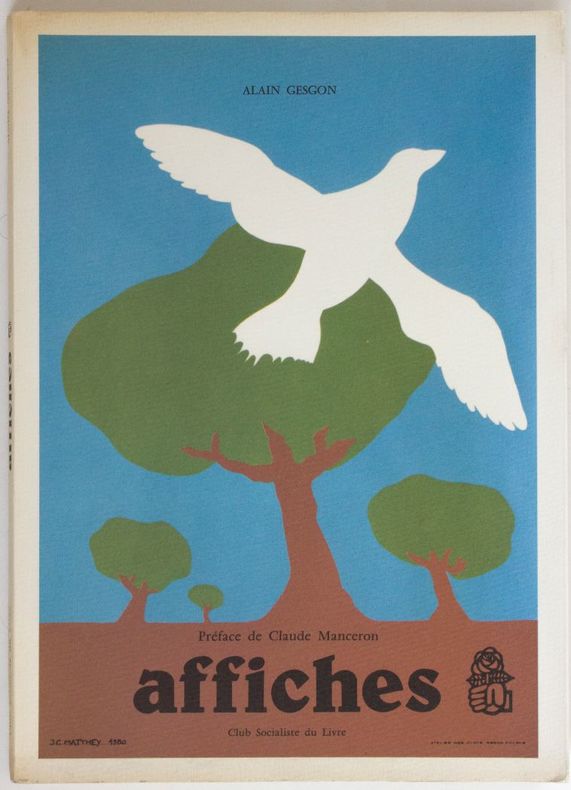
|
|
|
Gesgon Alain ; Mauroy (Pierre)
Affiches de Paix. Peace Posters Carteles de Paz
Fédération Mondiale des Cités Unies 1985 Livre en français, anglais, espagnol. In-4 cartonnage éditeur sous jaquette 33 cm sur 24. 131 pages. plus de 100 affiches reproduites pleine page en couleur. Jaquette frottée. Bon état d’occasion.
Ссылка продавца : 99492
|
|
|
GESSNER
Conrad Gessner 1516-1565. Affiche / Plakat
Ссылка продавца : 122513aaf
|
|
|
GESGON Alain
La laïcité sur les murs de France
Rennes, Editions du petit Démon, 2006, in-4 rel. cart. (24,5 x 31,5), 187 p., coll. "Les Affiches de l'histoire", 142 reproduction d'affiches, un dessin original pleine page de l'auteur sur page de garde, très bon état.
Ссылка продавца : QWA-12123
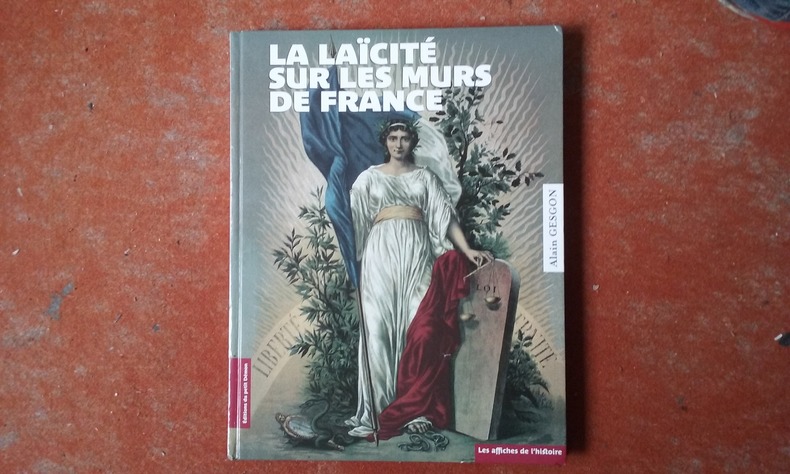
|
|
|
GESGON Alain
La mémoire murale politique des français de la Renaissance à nos jours. Catalogue - Exposition de la collection d'affiches politiques d'Alain Gesgon (La Conciergerie Janvier-Février 1984)
Synaps, 1984, broch. in-4 (21 x 30), 48 p., avant-propos de René Rémond, reproductions en n. et b. et en coul., très bon état.
Ссылка продавца : QWA-13133
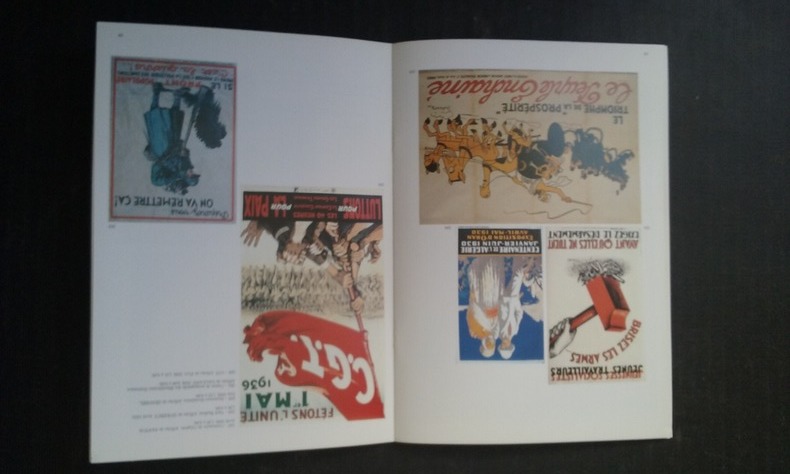
|
|
|
Gesgon, Alain
Le Parti socialiste sur les murs de France, 40 diapositives couleur
Sl Club socialiste du livre 1982 in-4 aucune reliure Sl, Club socialiste du livre, sd [ca 1982 ?]. 30 x 21 cm, dépliant imprimé et illustré et 40 diapositives réalisées d'après des affiches originales, l'ensemble dans un pochette platifiée dépliantes avec espaces de rangement.
Ссылка продавца : 4727
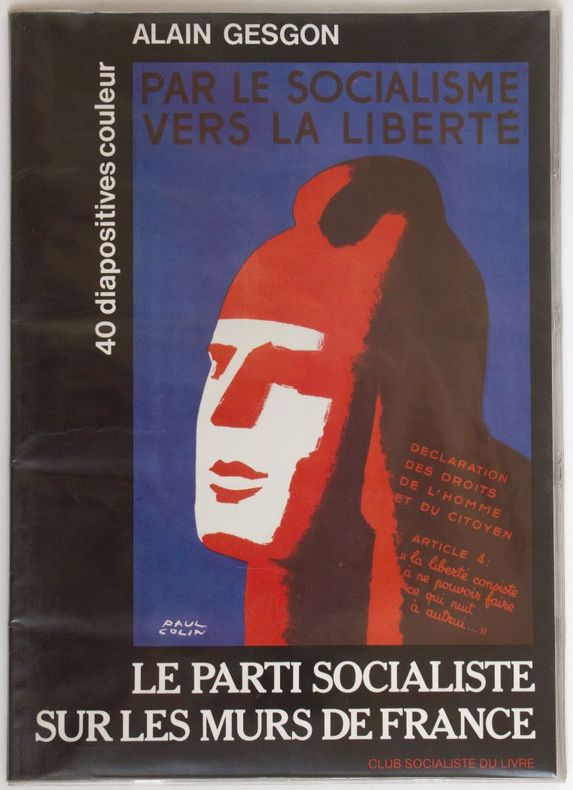
|
|
|
GETTING-JONAS-TITAN
"La Dayton - Cog - Belt"""
GJT (GETTING - JONAS - TITAN). Non daté. In-12. En feuillets. Bon état, Couv. convenable, Dos satisfaisant, Intérieur frais. 1 feuillet illustré en noir et blanc de 14 / 21cm (à l'italienne). Tampon. . . . Classification : 300-Affiches Divers
Ссылка продавца : RO80076337
|
|
|
GHOZLAND, Freddy ; LAURANS, Béatrice
Moscou S'affiche. Perestroïk’Art. URSS La Contestation Graphique. Graphic Protest In The USSR.
Milan - F. Ghozland, Toulouse 1991 Petit in-4 carré, cartonnage illustré, illustrations en couleurs, 102 pp. + 1 p de publicité pour l’URSS. En français et en anglais. Bon état général, couv. un peu salie.
Ссылка продавца : 20357
|
|
|
GHOZZI, Abdelaziz (texts and coordination) / SLAOUI, Abd.:
The Orientalist Poster: A Century of Advertising through the Abderrahman Slaoui Foundation Collection.
Malika editions Casablanca, 1997, in-4to, 143 p., colour plates, bibliog., index, losely inserted 2 ill. postcards from the collection orig. clothbound / 1st edition hardback with color illustrated dust jacket. Copy as new.
Ссылка продавца : 136368aaf
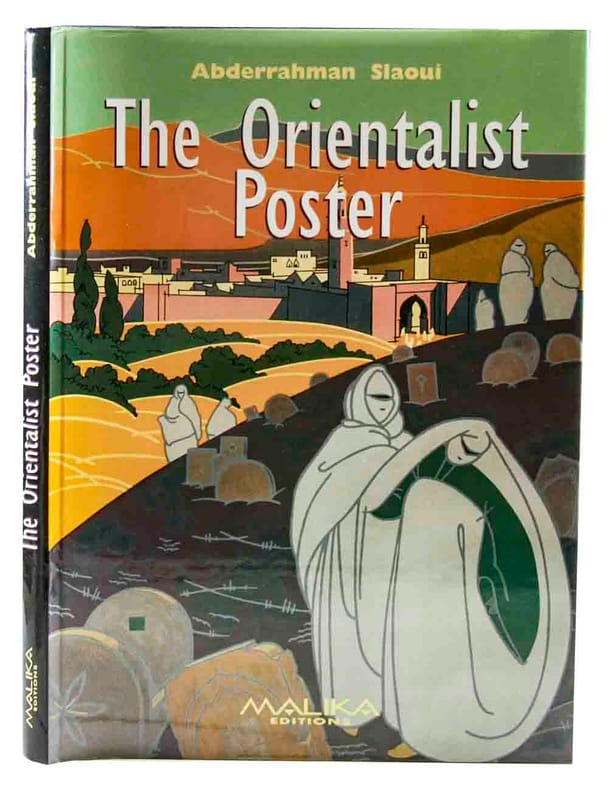
|
|
|
GHOZLAND, F. - Préface de Daniel Hemard, Président-Directeur Général de Pernod
Un siècle de réclames. Les boissons
1986 Editions Milan - 1986 - Petit in-4, cartonnage toilé gris sous jaquette illustrée de l'éditeur - Sans pagination - Très nombreuses illustrations et reproductions photographiques en couleurs et en N&B in et hors texte
Ссылка продавца : 114538
|
|
|
GHOZLAND E
Un Siècle De Reclames Alimentaires
Paris Milan 1999 In4 Non paginé - env. 100 pages - cartonnage editeur illustré - magnifiques reproductions - trés bon etat
Ссылка продавца : RES8L3
|
|
|
GHOZLAND E
Un Siècle De Reclames Alimentaires
Paris Milan 1999 In4 Non paginé - env. 100 pages - cartonnage editeur illustré - magnifiques reproductions - trés bon etat
Ссылка продавца : RES8L3
|
|
|
GHOZLAND Freddy
Une année de créations françaises mémoire d'affiche
Milan. 1990. In-8. Relié. Très bon état, Couv. remarquable, Dos impeccable, Intérieur frais. 102p, illustré à chaque page de photos couleurs d'affiches dans le texte, cartonné, couverture illustrée couleurs, jaquette illustrée.. Avec Jaquette. . A l'italienne. Classification Dewey : 741.67-Illustrations des affiches
Ссылка продавца : RO20020351
|
|
|
Ghozland (freddy)
Une annee de creations francaises, memoire de l'affiche
Milan 1960
Ссылка продавца : 48905
|
|
|
GHOZLAND, Freddy
Une Année de Créations Françaises. Mémoire de l'Affiche.
Milan - F. Ghozland, Toulouse 1990 In-8, oblong, cartonnage illustré, sous jaquette illustrée, illustrations en couleurs, 104 pp. Bon état d’occasion.
Ссылка продавца : 20356 ISBN : 286726619
|
|
|
GIACOMETTI (Alberto). Affiche.
Alberto Giacometti - dessins gravures lithographies.
Affiche 64 x 43 cm, exposition au chateau de Tanlay (Yonne) du 30 juin au 30 septembre 1984. Imp. Union Paris.
Ссылка продавца : 16728
|
|
|
Giacon Massimo:
Bored kitchen with TV set.
Vertige Graphic, sans date. Affiche au format 60 x 80 cm., en belle condition.
Ссылка продавца : 7012
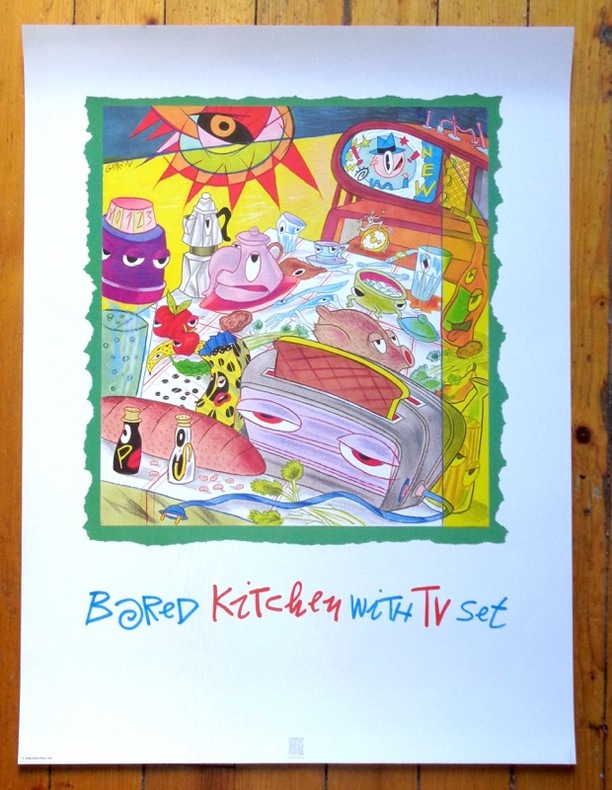
|
|
|
GIACOMETTI Alberto
Eau-forte originale
- Louis Broder, Paris s.d. (1965), 20x24,1cm, une feuille. - Eau-forte originale de Giacometti imprimée sur japon et réalisée pour l'ouvrage Feuilles éparses en hommage à René Crevel. Très bel exemplaire. [ENGLISH DESCRIPTION ON DEMAND]

|
|
|
Giacometti, Alberto
Alberto Giacometti. Les murs de l'atelier. Galerie Maeght 1979. [Plakat, Offsetdruck / poster offset print].
o.J. Alberto Giacometti, geboren am 10. Oktober 1901 in Borgonovo, Gemeinde Stampa; gestorben am 11. Januar 1966 in Chur. Schweizer Bildhauer, Maler und Grafiker.
Ссылка продавца : 9968DB

|
|
|
Gianfranco de Bosio Xarrié
Le terroriste.
français Sans date (1963). Affiche originale du film. 57,5x78,5 cm. Pliée.
|
|
|
Gibson (Mel)
Braveheart.
français Affiche de film (avec Mel Gibson, Sophie Marceau). 54x40 cm. Pliée.
|
|
|
Gibson (Mel)
Braveheart.
français Affiche de film (avec Mel Gibson, Sophie Marceau). 156x115 cm. Pliée.
|
|
|
Giger
Métal Hurlant (affiche de kiosque du n°21, septembre 1977, illustrée par Giger)
Humanoïdes associés Métal Hurlant Affiche 1977 "PEU COMMUN ET EN EXCELLENT ÉTAT. Affiche de Kiosque en papier cartonné au tirage réservé aux abonnés de la revue mensuelle Métal Hurlant, reprenant la couverture du numéro 21 (septembre 1977) ""100p. / Spécial nouveaux dessinateurs / Necromicron de Giger"", au format (30 x 40 cm.), dessin de Giger, rare ; ÉTAT PROCHE DU NEUF. Livraison a domicile (La Poste) ou en Mondial Relay sur simple demande."
Ссылка продавца : bf5220
|
|
|
Giger Hans Ruedi:
The passage of the temple - the path of the magician.
Gruyère, Musée H. R. Giger. Affiche du musée (épuisée) sous encadrement soigné. Imfimes frottements aux coins du cadre, pour le reste en belle condition.
Ссылка продавца : 14539

|
|
|
GILBERT & GEORGE ( Nés En 1942 Et 1943 )
Affiche originale "Art Exhibition GILBERT & GEORGE" Monaco, 14 Juin - 02 Novembre 2014.
Nouveau Musée National De Monaco Monaco 2014 Affiche originale en couleurs ( 80 X 60 cm ) de "Art Exhibition GILBERT & GEORGE" qui s'est tenue Villa Paloma à Monaco du 14 Juin au 02 Novembre 2014. Affiche en très bel état enrichie d'une dédicace autographe signée au feutre noir de GILBERT & GEORGE: "With love from GILBERT and GEORGE".
Ссылка продавца : 958865
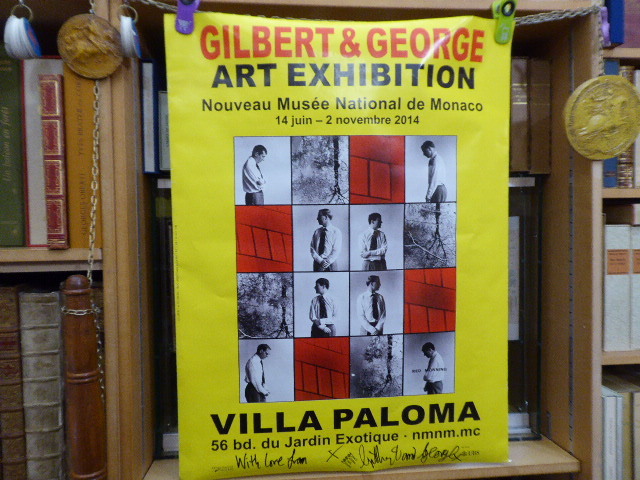
|
|
|
Gillon:
Gillon - Petite sérigraphie signée.
Sérigraphie en deux tons, au format 12 x 20 cm.
Ссылка продавца : 6307
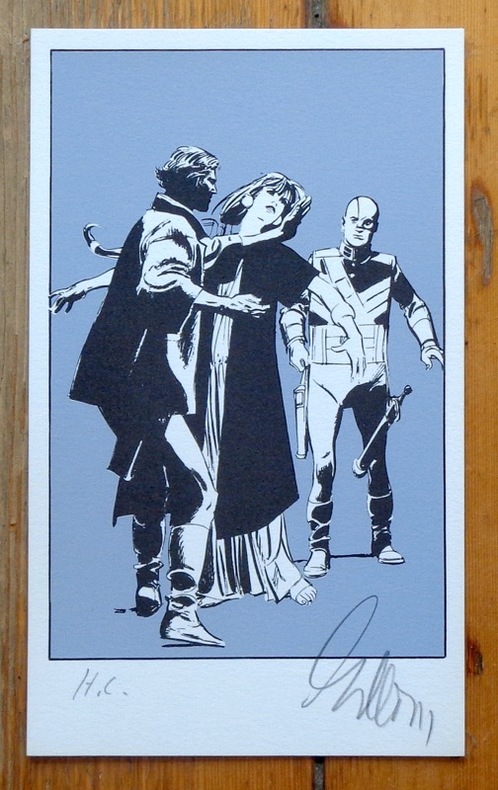
|
|
|
Gillon:
Petite sérigraphie.
Petite sérigraphie au format 12 x 20, tirage limité à 200 exemplaires numérotés, signés par l'artiste. Tampon de la Marge au dos. A l'état de neuf.
Ссылка продавца : 2002
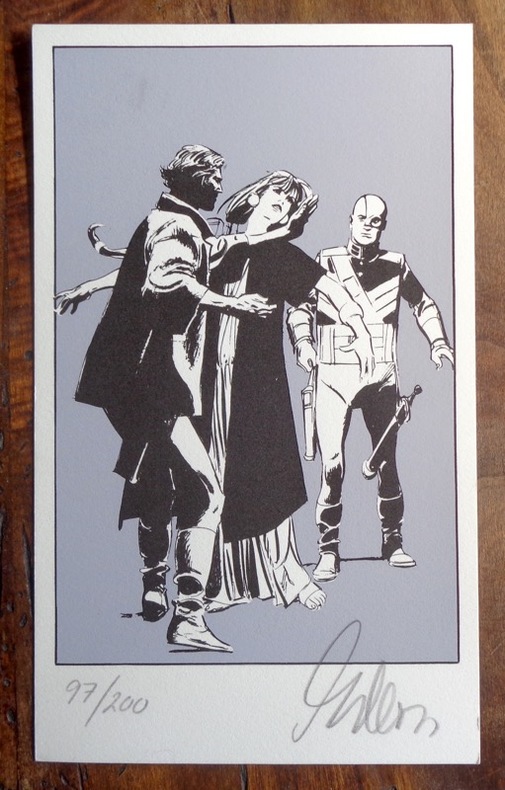
|
|